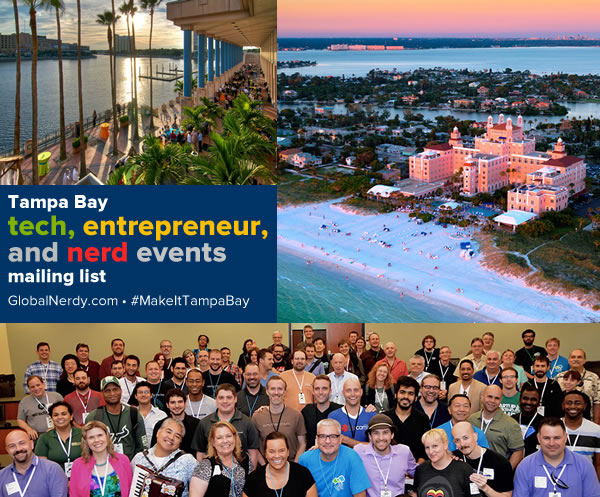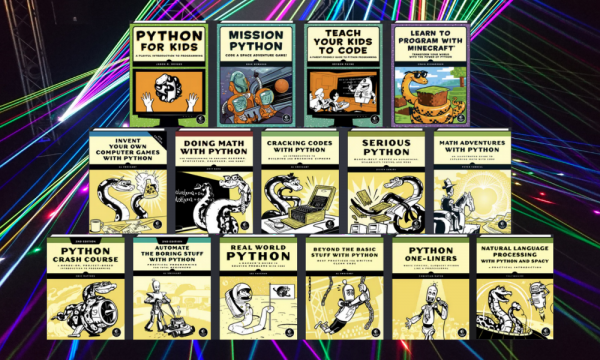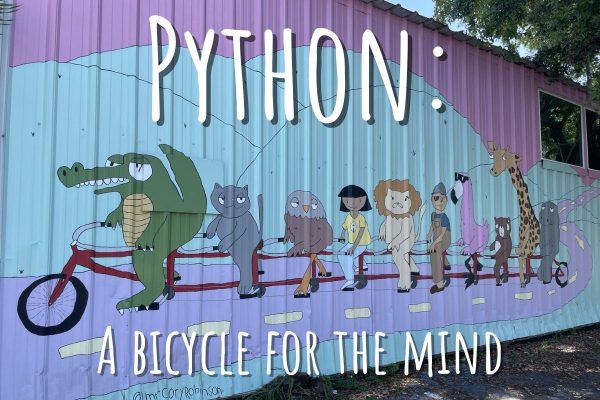
Welcome to June!
Here’s your list of tech, entrepreneur, and nerd events for Tampa Bay and surrounding areas for the week of Monday, May 31 through Sunday, June 6, 2021.
This is a weekly service from Tampa Bay’s tech blog, Global Nerdy! For the past four years, I’ve been compiling a list of tech, entrepreneur, and nerd events happening in Tampa Bay and surrounding areas. There’s a lot going on in our scene here in “The Other Bay Area, on the Other West Coast”!
By “Tampa Bay and surrounding areas”, this list covers events that originate or are aimed at the area within 100 miles of the Port of Tampa. At the very least, that includes the cities of Tampa, St. Petersburg, and Clearwater, but as far north as Ocala, as far south as Fort Myers, and includes Orlando and its surrounding cities.
How long will this list contain only ONLINE and OUTDOOR events?
Three Thursdays ago, the U.S. Centers for Disease Control and Prevention (CDC) announced that anyone who is fully vaccinated — meaning that they had their final vaccine two weeks or longer ago — can now stop masking and social distancing, including indoors in many cases. That means this list will start including in-person events, right?
Not just yet. This list will stick to online and outdoor events for the time being.
As I write this:
- 38.9% of the Florida population has been fully vaccinated (I’m one of them), and 49.0% has had their first dose.
- 41.0% of the U.S. population has been fully vaccinated, and 50.1% has had their first dose.
Those numbers are a good sign, but they could be better. I’m holding off on listing indoor in-person events until after the 4th of July for the following reasons:
- Most of the events aimed at a tech, entrepreneur, or nerd audience are still being held online.
- The CDC’s announcement depends on people exercising good judgement. We live in Florida. Do the math.
- If the CDC’s call was right, we’ll know by July 4th. If the CDC’s call was wrong, we’ll also know by July 4th.
I’m looking forward to life getting back to normal, but I’m also happy to exercise a few weeks’ worth of caution because I think it’s worth it.
Stay home, stay safe, stay connected, and #MakeItTampaBay!
This week’s events
Monday, May 31
Remember, it’s Memorial Day, and a number of Meetup groups are regularly scheduled on “autopilot”. The events listed for this day may ro may not actually be happening — check with the organizers to be sure!
- Entrepreneurs & Business Owners of Sarasota & Bradenton — Virtual Networking Lunch Monday & Wednesday @ 11:30 AM to 1:00 PM EDT
- Wesley Chapel, Trinity, New Tampa Business Professionals — Lutz, Wesley Chapel, New Tampa Virtual Networking Lunch @ 11:30 AM to 1:00 PM EDT
- Christian Professionals Network Tampa Bay — Live Online Networking- Monday @ 11:30 AM to 12:30 PM EDT
- Entrepreneurs Empower Empire — Office Hour @ 12:00 PM to 1:00 PM EDT
- Tampa Bay Investors & Traders — Stocktwits Meetups — Winning Wall Street’s Money with Stocks, Options, Futures, Forex, Crypto, etc @ 1:00 PM to 3:00 PM EDT
- Learn to play Mah Jongg, The Villages FL — Learn to Play American Mah Jongg @ 2:00 PM to 4:00 PM EDT
- Orlando Adventurer’s Guild — Candlekeep (Masters) Level 5 Price of Beauty @ 6:00 PM to 10:00 PM EDT
- Learn to play Mah Jongg, Orlando FL — Learn to Play American Mah Jongg @ 7:00 PM to 9:00 PM EDT
Tuesday, June 1
- Young Professionals of Tampa Bay Networking Group — Carrolwood Networking Breakfast @ 7:30 AM to 9:00 AM EDT
- Professional Business Networking with RGAnetwork.net — Tampa Bay Virtual Networking Breakfast Tuesday & Thursday All Welcome JOIN us @ 7:30 AM to 9:00 AM EDT
- Avocado Labs — Common XSS misconceptions – Q&A @ 10:00 AM to 10:30 AM EDT
- Tampa Bay Tech Career Advice Forum — Virtual Networking Success @ 10:00 AM to 11:30 AM EDT
- Keystone Mastermind Alliance – KMA Network — ZOOM at NOON – Virtual Meeting @ 12:00 PM to 1:30 PM EDT
- Toastmasters District 48 — Westshore Toastmasters @ 12:00 PM to 1:00 PM EDT
- Comics and Animation Meetup — 1602 @ 2:00 PM to 4:00 PM EDT
- Learn to play Mah Jongg, The Villages FL — Learn to Play American Mah Jongg @ 2:00 PM to 4:00 PM EDT
- WordPress St. Petersburg — Ask Us Anything: WordPress Support Crowdsourcing Meetup @ 6:30 PM to 8:30 PM EDT
- Suncoast Developers Guild — WordPress St Pete Meetup at SDG @ 6:30 PM to 8:30 PM EDT
- Code For Orlando — Community Action Night: Doughnuts & Discussions (Virtual) @ 6:30 PM to 7:30 PM EDT
- MakerFX Makerspace — MakerFX 3D Printing Meetup @ 7:00 PM to 8:00 PM EDT
- Tampa Hackerspace — THS Member Meeting Online @ 7:00 PM to 8:00 PM EDT
- Learn to play Mah Jongg, Orlando FL — Learn to Play American Mah Jongg @ 7:00 PM to 9:00 PM EDT
- Tampa Bay Investors & Traders — Stocktwits Meetups — Winning Wall Street’s Money with Stocks, Options, Futures, Forex, Crypto, etc @ 7:00 PM to 9:00 PM EDT
- Orlando Adventurer’s Guild — Icewind Dale: Rime of the Frostmaiden – (Tier 1, APL 2) – DM Canon @ 7:00 PM to 11:00 PM EDT
- The Orlando Girly Book Club — May’s Girly Book Club at 7 PM @ 7:00 PM to 9:00 PM EDT
- Shut Up & Write!® Tampa — Online Event: Shut Up & Write on Zoom @ 7:45 PM to 9:15 PM EDT
- Nerdbrew Events — Tampa Board Games Online @ 8:00 PM to 10:00 PM EDT
- Tampa Entrepreneurs Network — Create a post-pandemic plan based on your core values | Roy Prevost @ 8:00 PM to 10:00 PM EDT
Wednesday, June 2
- 1 Million Cups Orlando — Get a Bigger Boat / Atomic Sierra @ 9:00 AM EDT
- 1 Million Cups St. Pete — The Conjunction @ 9:00 AM EDT
- 1 Million Cups Tampa — Jesus, Tea, & Me @ 9:00 AM EDT
- North Tampa Networking Group — Business networking @ 9:00 AM to 10:00 AM EDT
- Wesley Chapel, Trinity, New Tampa Business Professionals — Lutz, Wesley Chapel, New Tampa Virtual Networking Lunch @ 11:30 AM to 1:00 PM EDT
- ProductTank Orlando — Make Problems Your Friend: reimagining problems to unlock hidden solutions @ 12:00 PM to 1:00 PM EDT
- Tampa Bay Agile — Heart of Agile Weekly Coffee Corner @ 12:30 PM to 1:45 PM EDT
- Free Video Production Classes – TV/Internet — Digital Video Editing Class (ONLINE CLASS) -FREE for Hillsborough residents only @ 1:00 PM to 3:00 PM EDT
- Learn to play Mah Jongg, The Villages FL — Learn to Play American Mah Jongg @ 2:00 PM to 4:00 PM EDT
- Orlando Unity Developers Group — Virtual Event: Blender Fundamentals @ 2:00 PM to 3:30 PM EDT
- Business Go-Getters (Service-Based Business Owners) — LIVE Q&A About How to Build Your Business @ 3:00 PM to 4:00 PM EDT
- Her Career Goals: Helping Millennial Women Thrive at Work — From Survive to Thrive: How to Calm the Chaos at Work @ 3:00 PM to 5:00 PM EDT
- Orlando Adventurer’s Guild — [Historic] Adventuring 331: Journies to the Beyond- DM Calvin (Tier 3) @ 6:00 PM to 10:00 PM EDT
- Tampa Bay Agile — Scrum Master Guild – The Coaching Conversation for Scrum Masters @ 6:00 PM to 8:00 PM EDT
- Toastmasters District 48 — Carrollwood Toastmasters Meetings now conducted Online using Zoom @ 7:00 PM to 8:30 PM EDT
- Keystone Mastermind Alliance – KMA Network — Workshop Wednesdays with KMA! @ 7:00 PM to 8:30 PM EDT
- Orlando 3D Printing Meetup — 1st Wednesdays: 3D Printing Latest Developments + Show & Tell ! @ 7:00 PM to 9:00 PM EDT
- Central Florida AD&D (1st ed.) Grognards Guild — New Beginnings & Old Rivalries @ 7:00 PM to 10:30 PM EDT
- MakerFX Makerspace — Orlando 3D Printing Meetup @ 7:00 PM to 9:00 PM EDT
- Learn to play Mah Jongg, Orlando FL — Learn to Play American Mah Jongg @ 7:00 PM to 9:00 PM EDT
- Tampa Bay Coalition of Reason — xpost: TIES Presents, Jon Perry of Stated Clearly, Inc! @ 8:00 PM to 9:00 PM EDT
- Comics and Animation Meetup — My Favorite Thing Is Monsters @ 8:00 PM to 10:00 PM EDT
- Nerdbrew Events — Sarah’s Arts Crafts and Bad TV Hangout Night @ 8:00 PM to 12 midnight EDT
- Sunshine State Startup: Idea to IPO — FREE! Pitch Practice: How to Pitch to Investors and Get the Deal @ 10:00 PM to midnight
Thursday, June 3
- Tampa Bay Tech Career Advice Forum — The Job Seekers Lunch Hour @ 12:00 PM to 1:00 PM EDT
- Orlando IT Community — CIS Controls masterclass: Three part webinar series @ 2:00 PM to 3:00 PM EDT
- Learn to play Mah Jongg, The Villages FL — Learn to Play American Mah Jongg @ 2:00 PM to 4:00 PM EDT
- Free Video Production Classes – TV/Internet — YouTube Basics (ONLINE CLASS) – FREE for Hillsborough County Residents @ 3:00 PM to 4:00 PM EDT
- Entrepreneurs & Startups – Bradenton Networking & Education — Founders Series Special – Finding Opportunity: Your COVID Recovery Series @ 5:30 PM to 7:00 PM EDT
- Entrepreneur Social Club — Entrepreneur Social Club at ZOOM Meeting @ 6:00 PM to 8:00 PM EDT
- Toastmasters District 48 — GREY MATTERS: The Forum For Open Minds @ 6:30 PM to 8:30 PM EDT
- Drupal User Group of Tampa Bay — Drupal Live Forum / Q&A @ 7:00 PM to 8:30 PM EDT
- Tampa Hackerspace — Online Electronics Guild Meetup @ 7:00 PM to 9:00 PM EDT
- Learn to play Mah Jongg, Orlando FL — Learn to Play American Mah Jongg @ 7:00 PM to 9:00 PM EDT
- Tampa Bay Investors & Traders — Stocktwits Meetups — Winning Wall Street’s Money with Stocks, Options, Futures, Forex, Crypto, etc @ 7:00 PM to 9:00 PM EDT
- Virtual Orlando Crypto-Growing for Newbies Club — How To Earn 60X Your Crypto Holdings Within The Next 12 Months WITHOUT RISK! @ 8:30 PM to 10:30 PM EDT
- Comics and Animation Meetup — Gender Queer @ 10:00 PM to 12 midnight EDT
Friday, June 4
- Orlando Digital Media Design Meetup — Virtual Event: Digital Painting Level 1 @ 10:00 AM to 11:00 AM EDT
- West Orlando WordPress Meetup — WordPress Collaboration Meetup ONLINE ONLY @ 10:00 AM to 11:30 AM EDT
- Tampa Bay Tech Career Advice Forum — How to Pull Yourself Up During a Job Search @ 10:00 AM to 11:30 AM EDT
- Toastmasters District 48 — Metropolitan Ministries Toastmasters Online! @ 11:45 AM to 1:00 PM EDT
- USWVDUG — USWVDUG: June Meetup @ 12:00 PM to 2:00 PM EDT
- Tampa Bay Investors & Traders — Stocktwits Meetups — Winning Wall Street’s Money with Stocks, Options, Futures, Forex, Crypto, etc @ 1:00 PM to 3:00 PM EDT
- Learn to play Mah Jongg, The Villages FL — Learn to Play American Mah Jongg @ 2:00 PM to 4:00 PM EDT
- Meeple Movers Gaming Group — Let’s Play Games ONLINE on Fridays! @ 5:30 PM to 8:30 PM EDT
- Central Florida AD&D (1st ed.) Grognards Guild — SKYPE AD&D 1E CAMPAIGN – PROTECTORS OF THE REALM! @ 7:00 PM to 11:00 PM EDT
- Learn to play Mah Jongg, Orlando FL — Learn to Play American Mah Jongg @ 7:00 PM to 9:00 PM EDT
- Orlando Adventurer’s Guild — Canon’s Custom Campaign Moonsea Tour (Tier 3) – DM Canon @ 7:00 PM to 11:00 PM EDT
Saturday, June 5
- Apollo Beach Maker Group — We have moved to Plant City @ 1:00 PM to 3:00 PM EDT
- Tampa Bay Investors & Traders — Stocktwits Meetups — Winning Wall Street’s Money with Stocks, Options, Futures, Forex, Crypto, etc @ 1:00 PM to 3:00 PM EDT
- Writers 4 All Seasons Tampa Bay — Writers 4 All Seasons Tampa Bay Zoom meeting @ 2:00 PM to 4:00 PM EDT
- Comics and Animation Meetup — The Best We Could Do: An Illustrated Memoir @ 4:00 PM to 6:00 PM EDT
- World Of Darkness RPG Meetup — Mage 20th: The Magick Throne @ 7:00 PM to 10:00 PM EDT
Sunday, June 6
- Tampa Bay Investors & Traders — Stocktwits Meetups — Winning Wall Street’s Money with Stocks, Options, Futures, Forex, Crypto, etc @ 1:00 PM to 3:00 PM EDT
- Dialogue and Human Experience. — Are we what we watch? @ 2:00 PM to 4:00 PM EDT
- Toastmasters, Division D — Weekend Toastmasters @ 3:00 PM to 4:30 PM EDT
- Orlando Stoics — ONLINE: Presentation at Stoic Salon: HELVIDIUS PRISCUS @ 5:00 PM to 6:00 PM EDT
Do you have any events or announcements that you’d like to see on this list?
Let me know at joey@joeydevilla.com!
Join the mailing list!
If you’d like to get this list in your email inbox every week, enter your email address below. You’ll only be emailed once a week, and the email will contain this list, plus links to any interesting news, upcoming events, and tech articles.
Join the Tampa Bay Tech Events list and always be informed of what’s coming up in Tampa Bay!















